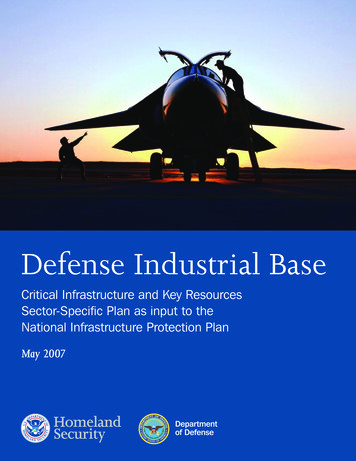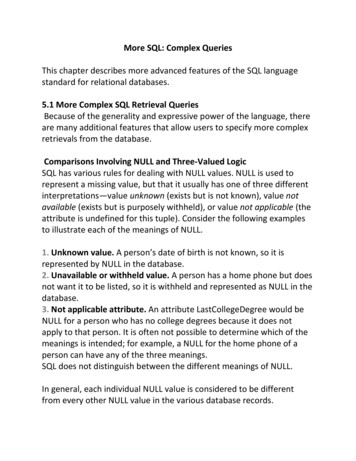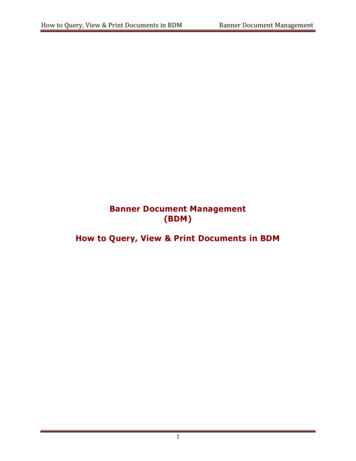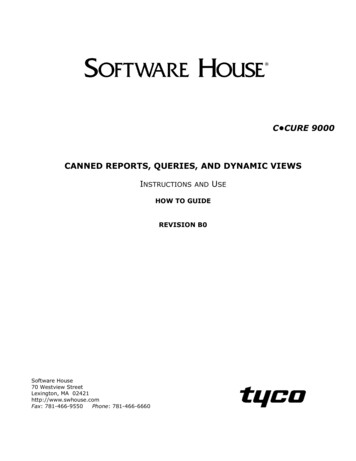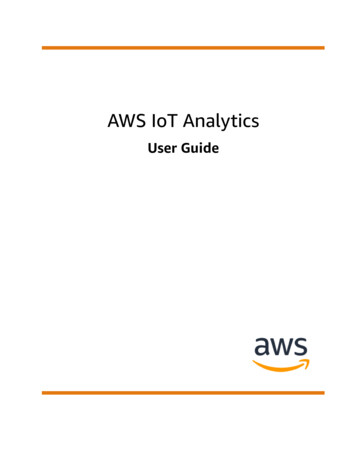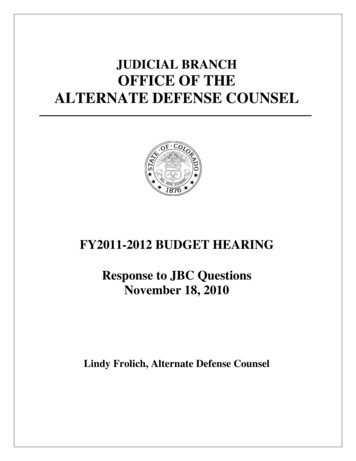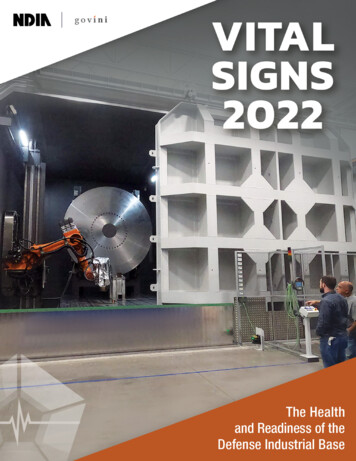
Transcription
February 2022First published in 2022 by NDIA.org, 2101 Wilson Blvd, Suite 700, Arlington, VA 22201, United States of America.(703) 522-1820 2022 by the National Defense Industrial Association. All rights reserved.This report is made possible by general support to NDIA. No direct sponsorship contributed to this report. This report isproduced by NDIA, a non-partisan, non-profit, educational association that has been designated by the IRS as a 501(c)3nonprofit organization—not a lobby firm—and was founded to educate its constituencies on all aspects of national security. Its research is nonpartisan and nonproprietary. NDIA does not take specific policy positions. Accordingly, all views,positions, and conclusions expressed in this publication should be understood to be solely those of the author(s).For the link to the PDF, see: NDIA.org/VitalSigns2022For more information please visit our website: NDIA.orgMEDIA QUERIES:Evamarie SochaDirector of Public Relations and Communications(703) 247-2579esocha@NDIA.org
NDIA VITAL SIGNS 2022TABLE OF CONTENTSTable of contents . . . . . . . . . . . . . . . . . . . . . . . . . . . . . . . . . . . . . . . . . . . . . . . . . . . . . . . . . . . . . . . . . . . . . . . . . . . . . . . . . . . . . . . . . . . . . . . . 3Forewords. . . . . . . . . . . . . . . . . . . . . . . . . . . . . . . . . . . . . . . . . . . . . . . . . . . . . . . . . . . . . . . . . . . . . . . . . . . . . . . . . . . . . . . . . . . . . . . . . . . . . . . . . . . 4Contributors. . . . . . . . . . . . . . . . . . . . . . . . . . . . . . . . . . . . . . . . . . . . . . . . . . . . . . . . . . . . . . . . . . . . . . . . . . . . . . . . . . . . . . . . . . . . . . . . . . . . . . . . 5Executive summary. . . . . . . . . . . . . . . . . . . . . . . . . . . . . . . . . . . . . . . . . . . . . . . . . . . . . . . . . . . . . . . . . . . . . . . . . . . . . . . . . . . . . . . . . . . . . . 6Introduction. . . . . . . . . . . . . . . . . . . . . . . . . . . . . . . . . . . . . . . . . . . . . . . . . . . . . . . . . . . . . . . . . . . . . . . . . . . . . . . . . . . . . . . . . . . . . . . . . . . . . . . . 8How we score Vital Signs. . . . . . . . . . . . . . . . . . . . . . . . . . . . . . . . . . . . . . . . . . . . . . . . . . . . . . . . . . . . . . . . . . . . . . . . . . . . . . . . . . . . . 11Demand. . . . . . . . . . . . . . . . . . . . . . . . . . . . . . . . . . . . . . . . . . . . . . . . . . . . . . . . . . . . . . . . . . . . . . . . . . . . . . . . . . . . . . . . . . . . . . . . . . . . . . . . . . . . 13Production inputs. . . . . . . . . . . . . . . . . . . . . . . . . . . . . . . . . . . . . . . . . . . . . . . . . . . . . . . . . . . . . . . . . . . . . . . . . . . . . . . . . . . . . . . . . . . . . . 16Innovation. . . . . . . . . . . . . . . . . . . . . . . . . . . . . . . . . . . . . . . . . . . . . . . . . . . . . . . . . . . . . . . . . . . . . . . . . . . . . . . . . . . . . . . . . . . . . . . . . . . . . . . . . 23Supply chain. . . . . . . . . . . . . . . . . . . . . . . . . . . . . . . . . . . . . . . . . . . . . . . . . . . . . . . . . . . . . . . . . . . . . . . . . . . . . . . . . . . . . . . . . . . . . . . . . . . . . 27Competition. . . . . . . . . . . . . . . . . . . . . . . . . . . . . . . . . . . . . . . . . . . . . . . . . . . . . . . . . . . . . . . . . . . . . . . . . . . . . . . . . . . . . . . . . . . . . . . . . . . . . . 30Industrial security. . . . . . . . . . . . . . . . . . . . . . . . . . . . . . . . . . . . . . . . . . . . . . . . . . . . . . . . . . . . . . . . . . . . . . . . . . . . . . . . . . . . . . . . . . . . . . 35Political and regulatory. . . . . . . . . . . . . . . . . . . . . . . . . . . . . . . . . . . . . . . . . . . . . . . . . . . . . . . . . . . . . . . . . . . . . . . . . . . . . . . . . . . . . . . 38Productive capacity and surge readiness. . . . . . . . . . . . . . . . . . . . . . . . . . . . . . . . . . . . . . . . . . . . . . . . . . . . . . . . . . . . . . 42Emerging technology. . . . . . . . . . . . . . . . . . . . . . . . . . . . . . . . . . . . . . . . . . . . . . . . . . . . . . . . . . . . . . . . . . . . . . . . . . . . . . . . . . . . . . . . . . 47Vital Signs survey results. . . . . . . . . . . . . . . . . . . . . . . . . . . . . . . . . . . . . . . . . . . . . . . . . . . . . . . . . . . . . . . . . . . . . . . . . . . . . . . . . . . . 50Conclusion. . . . . . . . . . . . . . . . . . . . . . . . . . . . . . . . . . . . . . . . . . . . . . . . . . . . . . . . . . . . . . . . . . . . . . . . . . . . . . . . . . . . . . . . . . . . . . . . . . . . . . . . 56Appendix. . . . . . . . . . . . . . . . . . . . . . . . . . . . . . . . . . . . . . . . . . . . . . . . . . . . . . . . . . . . . . . . . . . . . . . . . . . . . . . . . . . . . . . . . . . . . . . . . . . . . . . . . . 57ABOUT THE COVER IMAGEPictured on the cover is the largest electron-beam weldingsystem in the Western Hemisphere. Located in Huntsville, AL, the22-foot-long electron beam is capable of welding additively manufactured scramjet sections with materials as thin as aluminum foilto full-scale ship hulls that are five inches thick. This technologywill weld hardware for Virginia- and Columbia-class submarines.3
NDIA VITAL SIGNS 2022FOREWORDSNDIAFor the first time, because of the evolving impact of the COVID-19pandemic and the sustained challenges noted in past reports, ourVital Signs study has scored the health of the defense industrialbase below a passing grade. As this report reflects the challengingenvironment in which defense companies operate — rather than thecompanies themselves — this score serves as a wake-up call to allwho care about the state of our national security. While the COVID19 pandemic continues, so does the critical work of the defenseindustry. The pandemic reinforces the fact that our defense industrial base is not isolated from the American economy or the globalbusiness environment: now, more than ever, we must pay heed tothe health of our base as it serves our warfighters.In 2021, our economy was beset with a host of disruptionsrelated to COVID-19 including workforce shortages, inflation, andsupply chain disruptions — conditions that we had yet to observeat such a large scale during the first year of the pandemic. At thesame time, cybersecurity and intellectual property threats continued unabated. Aggressive military actions by Russia and the rapidmilitary modernization efforts of China’s government continued toalarm policymakers, friends, and allies. These challenges remindus that our industry’s work of providing a superior operating environment and products and services to our armed forces, so thatthey can compete and win in all domains of warfare, can never betaken for granted.Again, it is important to emphasize Vital Signs does not assessthe performance of our defense companies. The current health ofthe defense industrial base renders a sobering challenge to policymakers on Capitol Hill, leaders in the executive branch of government, scholars in academia, and other thought leaders. We hopethat Vital Signs, and other research efforts by the National DefenseIndustrial Association, will form part of the remediation process aswe discuss and address the impact of COVID-19 and the underlying concerns that remain.General Herbert “Hawk” Carlisle, USAF (Ret)NDIA President & CEOGOVINIAt the same time, the U.S. must balance efforts to spark andfoster innovation with the need to ensure the defense industrial baseis sufficiently resilient. And as the COVID-19 pandemic has starklydemonstrated, this resilience must not only protect the industrialbase against exploitation or disruption by China, but also enable it towithstand a host of potential economic and environmental shocks.This is why Vital Signs 2022 is so, well, vital. Now in its third year,the report’s data-driven approach not only provides an empiricalassessment of the health and readiness of the defense industrial base over time, but also offers the first real accounting of thedamage wrought by the pandemic. Without efforts such as VitalSigns, it would be impossible to accurately understand the fullextent of the problems facing the defense industrial base or todevelop and implement effective solutions. How well the U.S. doesso may be the difference between victory or defeat.The techno-military confrontation between the U.S. and China willlikely not be decided in some contested stretch of the westernPacific, but rather right here at home. If the United States is goingto prevail in this confrontation, it must better harness the innovation engine that is the American economy. Successfully doing so,however, is a complex and challenging endeavor.China is already a more formidable economic competitor thanthe Soviet Union ever was during the Cold War, and its economicmight will likely only continue to grow. The U.S. cannot simply outspend its way to victory this time around. As a result, the U.S.national security enterprise must work more effectively and efficiently with the existing defense industrial base.But military advantage on future battlefields will not solelystem from who can better churn out a new generation of warships, planes, and tanks. It will also depend on which side canbest adapt emerging technologies from the commercial sector formilitary use. Therefore, the national security enterprise must alsobroaden the industrial base to incorporate non-traditional partnersthat are building technologies, such as artificial intelligence, thatwill define the future.Tara Murphy DoughertyChief Executive Officer, Govini4
NDIA VITAL SIGNS 2022CONTRIBUTORSNDIAHeberto Limas-VillarsJunior Policy FellowHarvard Kennedy School of GovernmentPolicy TeamCol Wesley Hallman, USAF (Ret)PublicationsSenior Vice President, Strategy & PolicyEditingHabiba HamidNicholas JonesEditor, Marketing & CommunicationsEditingDirector, Regulatory PolicyEditingHannah MeushawSenior Graphic Designer, Marketing & CommunicationsLayout and DesignRobert Van SteenburgAssociate, Regulatory PolicyData, Writing, and EditingEve DorrisDirector, Information Production Office, Marketing &CommunicationsDesign SupportSamantha BeuAssociate Research Fellow, ETIData, WritingEvamarie SochaDirector, Public Relations & Communications, Marketing &CommunicationsMedia OutreachResearch SupportJack EllrodtGOVINIJunior Policy FellowEdmund A. Walsh School of Foreign Service GeorgetownUniversityMatt WiestEngagement ManagerDanyale KelloggJoe HsuJunior Policy FellowGeorge Mason Schar School of Policy and GovernmentAnalystBilly FabianJoshua WalkerVice President, StrategyJunior Policy FellowUC San Diego School of Global Policy & StrategyBob RheaSenior Vice President, Mission SolutionsAndrew SenesacJen GebhardtJunior Policy FellowJohns Hopkins SAISAnalystAndy ShawElliot SecklerMarketingJunior Policy FellowJohns Hopkins SAISAlison SommerGraphic DesignerMichael JohnsJunior Policy FellowHarvard Kennedy School of GovernmentNicholas LapinskiJunior Policy FellowJohns Hopkins Krieger School5
NDIA VITAL SIGNS 2022EXECUTIVE SUMMARYThis year’s iteration of Vital Signs: The Health and Readiness of theDefense Industrial Base marks the third consecutive year that theNational Defense Industrial Association offers an unclassified analysis of the state and performance of America’s defense industrialbase (DIB) as an enterprise.Accessible to both the American public and defense policycommunity, Vital Signs 2022 strives to provide a comprehensiveassessment of the resiliency of the defense sector by standardizing and integrating a set of criteria that reviews its performance inthe context of the overall business environment.The report frames the health of the defense industrial base asessential to economic and national security and does not examine individual companies or the Department of Defense (DoD)specifically, but rather the challenging environment in which allstakeholders operate.When researching Vital Signs 2022, NDIA examined data relatingto eight “signs” that collectively shape the performance of defensecontractors. In a departure from Vital Signs 2021, this year’s reportindicates a final grade of “Unsatisfactory, Failing” for the healthand readiness of the defense industrial base (DIB). While technically one point short of a pass mark, specific signs provide causefor real concern.This year, five of the eight signs received a failing grade. Thisreflects the tumultuous state of the industry as it grappled withthe extraordinary ramifications of the COVID-19 pandemic, whichdramatically disrupted the lives of individual Americans as well asglobal commerce.This past year has witnessed significant deterioration in thesigns including “supply chain” as well as “production capacity andsurge readiness,” which almost certainly is a result of the impact ofthe pandemic. Conversely, the only sign that significantly improvedwas “demand,” reflecting recent growth in the defense budget.Vital Signs 2022 also reflects the story of recent political andregulatory action against adversaries and their influence over theDIB, and the way in which that has shaped and will continue toshape the future of the warfighter.this sign received a score of 50 in 2021, the lowest among theeight signs in 2022. To assess the “industrial security” sign, NDIAanalyzed threat indicators to information security and intellectualproperty (IP) rights. The score incorporates the nonprofit MITRECorp.’s annual average of the threat severity of new cyber vulnerabilities. This year, the analysis included the new National Instituteof Standards and Technology’s 3.1 scoring system, supersedinglast year’s usage of the 2.7 system. Threats to IP rights scored wellat 80 in 2021, as the number of FBI investigations into intellectualproperty violations declined to 38. This pattern marks a steadydecline since investigations reached an all-time high of 235 in 2011.Defense industry “production inputs” also scored poorly in 2021,receiving a failing score of 67. These inputs encompass skilledlabor, intermediate goods and services, and raw materials usedto manufacture or develop end-products and services for defenseconsumption. In particular, the indicators for security clearanceprocessing contributed to the low score for “production inputs”,as on-boarding backlogs persist.OVERALL SCORESChange,2020 – 2021Condition201920202021Demand828894 6Production inputs666667 1Innovation6969690Supply chain607163-8Competition9288880Industrial security494950 1Political & regulatory787672-4Productive capacity & surgeReadiness806752-15Overall health and readiness727269-30 1 – 5Figure 0.1Factor score key-6 and worseAREAS OF CONCERN-1 – -5 6 and betterAREAS OF CONFIDENCEAs a majority of the eight signs received failing grades for the firsttime this year, Vital Signs 2022 reveals a DIB that, similar to otherindustries, suffered sustained losses during the COVID-19 pandemic. Six of the indicators earned composite scores lower than80 and five of these earned scores below 70, a grade consideredfailing. These scores point to a DIB struggling to meet the unprecedented and ongoing challenges created by the pandemic in theface of an increasing challenge from competitor nations.“Industrial security” has gained renewed prominence due to databreaches and brazen acts of economic espionage, perpetrated byboth state and non-state actors, that have plagued defense contractors. However, despite the importance of “industrial security”,Despite numerous negative scores, areas of confidence give causefor optimism within the defense industrial base. For instance,demand for defense goods and services remained robust in 2021and received an outstanding score of 94. This increase stems froma rise in contract obligations issued by the DoD. Moving forward,this will be an indicator to closely monitor, as the prospect of flatter defense budgets and rising inflation pose potential headwindsin the near term.“Competition” was also a strength. An analysis of the top 100publicly-traded DoD contractors, conducted by decision sciencecompany Govini, produced a competition score of 88 for 2021.6
NDIA VITAL SIGNS 2022HOW HAS THE DEFENSEINDUSTRIAL BASE RESPONDEDTO THE PANDEMIC?This high mark was driven by several high-scoring factors including a low level of market concentration for total contract awards,the low share of total contract awards received by foreign contractors, and a high level of capital expenditure in the DIB.Conversely, other factors within the “competition” sign experienced decreases, including a significant 11-point decrease forliquidity. These decreases were anticipated, however, due to theimpact of the pandemic on the economy.The ability of the defense industrial base to expand output and fulfillincreased military demand is a key test of its health and readiness.The COVID-19 pandemic, which began in early 2020 in the USA,exemplifies this. In 2021, “productive capacity and surge readiness” earned a critical risk score of 52. This represents a 15-pointdecrease from 2020 and can largely be attributed to declines inoutput efficiency. However, it is important to note that this score isnot based upon a fully mobilized economy, similar to the contextof World War II. Rather, the “production capacity and surge readiness” sign is baselined against the late Cold War defense buildup,a surge of 31% that began during the Carter administration andaccelerated throughout the Reagan presidency.The critical impact of COVID-19 also became evident in the“supply chain” sign, which experienced an 8-point drop that islargely attributed to a worsening in cash conversion cycles for thetop 100 defense contractors. Also, as indicated by our survey,workforce challenges and the availability of talent are a criticalconcern. Interestingly, the pandemic also changed the makeup ofthe top 100 defense contractors, with pharmaceutical companyModerna, the maker of one of the approved COVID-19 vaccines,making it onto the list.The health and readiness of the DIB poses a challenge to thenational security community. As the DIB evolves to meet new andcomplex challenges, Vital Signs 2022 highlights several obstaclesthe nation must overcome, especially in light of the continuingpandemic.As always, NDIA intends Vital Signs 2022 to be a referencedocument that sets forth conditions for an annual discussion ondefense sector issues. It is NDIA’s hope that this report contributesto the critical debate surrounding the nation’s defense acquisitionstrategy by offering a common set of fact-based data points onindustrial partners that give the men and women in uniform, andtheir civilian counterparts, an advantage in all domains of warfare.It is the hope of NDIA that Vital Signs 2022 will help inform policydiscussions that lead to improvements in the health and readiness of the industrial base and a higher overall grade in Vital Signs2023, and beyond.OTHER TAKEAWAYSIn 2021, the “innovation” sign remained stagnant and received anunsatisfactory score of 69.Scores also declined for the “political and regulatory” sign. Inearly 2020, prior to the onset of the pandemic, 50% of participantsbelieved that defense spending is “about right,” which marked a7% increase from 43% in 2019. This 2020 result of 50% is the highest percentage of “about right” responses for this question sinceGallup began asking it more than 52 years ago.“Acquisition reform” and “budget stability,” two of NDIA’s strategic priorities, once again topped the list of concerns for industryleaders. In the Vital Signs survey, participants were asked aboutthe most important thing government could do to help the defenseindustrial base. Respondents stated that both streamlining theacquisition process, 37.6%, and budget stability, 27.8%, were paramount, which is consistent with last year’s findings.Similarly, a vast majority, 72.3%, cited uncertain businessconditions when asked to cite what conditions would limit theirwillingness to allocate additional capacity to military production.And 62.8% of survey respondents cited the burden of governmentpaperwork as a deterrent. Both findings underscore the continuedimportance of acquisition reform and budget stability.7
NDIA VITAL SIGNS 2022INTRODUCTIONFor the first time since NDIA began producing this annual report onthe health and readiness of the Defense Industrial Base (DIB), thedata shows less than a passing grade. This finding supports theDepartment of Defense (DoD)’s FY20 Annual Industrial CapabilitiesReport which points out that “our defense industrial base hasreached an inflection point in its history regarding the balancebetween its vulnerabilities and its opportunities for modernizationand reform.”1 Facing the challenges of the COVID-19 pandemic,as well as strategic competition from countries like China, thismoment is of unique importance to the DIB and ultimately to ournation’s long-term security.Despite the historically vital role of the DIB in supportingAmerica’s armed forces during peace and war, U.S. defense policyhas not always recognized that vital role. For example, congressional panels on the defense industrial base convened by the HouseArmed Services Committee in 1980, 1992, and 2011 called attentionto U.S. defense policy’s persistent neglect of the defense industrial base and the potential tactical and strategic ramifications forthe nation in a conflict against a near-peer adversary. 2 In 2017,Executive Order 13806 identified important structural changes tothe U.S. manufacturing sector that “raise[d] concerns about thehealth of the manufacturing and defense industrial base” and calledfor a “comprehensive evaluation” to help guide future remedialpolicy actions.3 As the executive order suggests, a key obstacleto a sound DIB strategy is a common baseline understanding ofthe overall health and readiness of the DIB.As in past issues, this annual report is the defense industrialbase’s yearly health check-up; accordingly, it aims to encourageconversations at all levels about how to adjust policies and makeinvestments that maintain the superior readiness of the AmericanDIB while providing the continued advantages our nation and itswarfighters have come to expect. NDIA, in partnership with Govini, adecision science company, has completed our third annual assessment of the health and readiness of the DIB to address the gapin a common baseline understanding of the overall health of theDIB. By analyzing select statistical indicators, NDIA uses a uniquecomposite indicator consisting of a set of eight signs, providing anintegrated measure of the health and readiness of the U.S. DIB asan ecosystem. This is a measure more of the challenging environment within which DIB companies operate, rather than a measureof the companies themselves. Given that this synoptic indicatorbrings together data on multiple sets of factors affecting the defenseindustry, it facilitates a common, holistic understanding of the stateof the defense industrial base and its “vital signs.”WHAT IS THE DEFENSEINDUSTRIAL BASE?The U.S. defense industrial base partners with the DoD to ensurethat the U.S. enjoys decisive advantages to compete, deter, andwin. The DIB encompasses manufacturers, systems integrators,service providers, technology innovators, labs and research organizations, and other suppliers linked to one another by contracts intoregional, national, and global supply chains to provide America’swarfighters with superior tools, capabilities, and resources.4 Inrecent years, the U.S. DIB has declined in size, and in the numberof new entrants, despite growing demand for its output. DoD is thelargest contracting agency in the federal government. Total contract obligations issued by DoD grew from 368 billion in 2018 to 429 billion in 2020 (the last full-year data available).Defense supply chains touch every state in the Union. Accordingto data from DoD’s Office of Local Defense Community Cooperation,defense contract spending in FY20 averaged over 7 billion perstate and in the District of Columbia, although spending levelsvaried widely.5 For example, Texas received the most of all stateswith 83 billion in defense contract spending while Wyomingreceived the least of all states with less than 200 million.6 Theconcentration of defense contract spending in major metropolitanareas supports clusters of defense industry production, investment, and employment. The metropolitan areas of WashingtonD.C.-Baltimore, Dallas-Fort Worth, San Diego, Seattle, St. Louis,Los Angeles, Huntsville, and Boston host the country’s largest1Department of Defense, “FY20 Annual Industrial Capabilities Report,” January 2021. Accessed July 21, 2021. ed States House Committee on Armed Services. (1980). The ailing defense industrial base: unready for crisis. Report of the Defense Industrial Base Panel of theCommittee on Armed Services, House of Representatives. Ninety-sixth Congress, Second Session. Washington: U.S. G.P.O.; United States House Committee onArmed Services. (1992). “Defense industrial base: hearings before the Structure of U.S. Defense Industrial Base Panel of the Committee on Armed Services,” Houseof Representatives, One Hundred-Second Congress. Washington: U.S. G.P.O.; United States House Committee on Armed Services. (2012). “The defense industrialbase: a national security imperative: hearing before the Panel on Business Challenges within the Defense Industry of the Committee on Armed Services,” House ofRepresentatives3Trump, President Donald J., “Presidential Executive Order on Assessing and Strengthening the Manufacturing and Defense Industrial Base and SupplyChain Resiliency of the United States,” July 21, 2017; Available at: https://www.whitehouse.gov/presidential-actions/ in-resiliency-united-states/4Definitions of the “defense industrial base” vary in their inclusiveness. We adopt a broad definition of the defense industrial base in recognition of the growing size,diversity, and complexity of the supply networks that support America’s warfighters.5U.S. Department of Defense, Office of Economic Adjustment, “Defense Spending by State - Fiscal Year 2020.” October 22, 2021. Accessed December 15, ending-by-state-in-fiscal-year-2020/6Ibid.8
NDIA VITAL SIGNS 2022New Vendors By Place of Performance, FY20DAFAsAir ForceArmyNavyFigure 0.2, Source: GoviniTHE EVOLVING DEFENSEINDUSTRIAL BASE: FROM THECOLD WAR TO TODAYdefense contracting clusters.7 Historically, defense procurementhas followed a decadal cyclical pattern, driven by events and policychanges.8 The breakout of major military conflicts has prompteddefense spending peaks with a typical concentration in the high-volume procurement of major defense acquisition programs (MDAPs).Spending troughs have followed such peaks when military conflictsand tensions have deescalated, driving industry consolidation. Forthe U.S. DIB, these cyclical changes reflect the challenges defensecontractors have when maintaining thriving companies while alsomaking critical investments in future capabilities. The globalizationof supply chains have only served to exacerbate those challenges.The 2018 National Defense Strategy (NDS)’s declaration of there-emergence of an era of great-power competition has held significant implications for the defense industrial base. The NDS calledfor reforms to defense acquisition systems to ensure the promptdelivery of important capabilities, services, and materials to U.S.warfighters in step with the changing strategic environment. This eraof great-power competition presents the challenge of a multi-domain competition with peer and near-peer competitors, specificallyChina and Russia. Achieving decisive national advantages acrossemerging technologies — artificial intelligence, hypersonic aviation, quantum computing, autonomy, and human-machine teamingsystems, among others — will have significant implications for thefuture of economic and strategic balances of power. This newera also challenges industry to achieve high levels of readiness to7Department of Defense “FY20 Annual Industrial Capabilities Report,” January 2021. Accessed July 21, 2021. s, Barry D., “The US defense industrial base: Past, present, and future,” Center for Strategic and Budgetary Assessments, Washington DC, 2008.9
NDIA VITAL SIGNS 2022VITAL SIGNS SURVEY RESULTSrapidly grow the production and deployment of military hardwareduring a conflict against a near-peer competitor. Nevertheless,trends from previous eras will continue to affect the defense industrial base. Growing dangers to industrial security from cybersecuritythreats and traditional economic espionage will require defensecontractors to implement new and often costly security proceduresand systems. Such dynamic and uncertain business conditions ofthis emerging era will undoubtedly bring changes to both the organization and behavior of firms within the defense industrial base.For Vital Signs 2021, NDIA fielded a thirty-two-question survey toour members. This year’s survey focused on questions that will berelevant every year (i.e. related to the DIB’s capacity to surge) andquestions that are relevant to this year (i.e., related to the impactsof COVID-19). The survey results are used throughout Vital Signs2022 while key results are presented in a single, dedicated section of the report.FOR THE FUTUREUNDERSTANDING THE HEALTH OFTHE DEFENSE INDUSTRIAL BASEVital Signs 2022: The Health and Readiness of the DefenseIndustrial Base is the third installment of the Vital Signs series.This report makes conclusions on the overall health and readinessof the defense industrial base. W
When researching Vital Signs 2022, NDIA examined data relating to eight "signs" that collectively shape the performance of defense contractors. In a departure from Vital Signs 2021, this year's report indicates a final grade of "Unsatisfactory, Failing" for the health and readiness of the defense industrial base (DIB). While techni-
